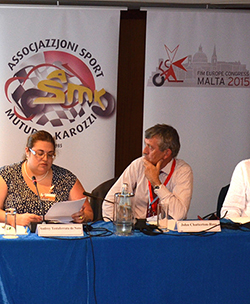 Perhaps because we are getting a bit jaded or just because as Right To ride EU we will be retiring shortly, but this conference in a long line of endless safety conferences seems the same as the last one and the last one before that. They all appear to be an exercise in cerebral masturbation.
Perhaps because we are getting a bit jaded or just because as Right To ride EU we will be retiring shortly, but this conference in a long line of endless safety conferences seems the same as the last one and the last one before that. They all appear to be an exercise in cerebral masturbation.
While this may seem somewhat negative, we do think that these conferences serve a purpose. Not just for a meeting of minds but for ideas that may or may not come to the fore over and beyond that of “solving” issues of motorcycle safety or just to network.
One issue that is just starting to do the rounds was mentioned by John Chatterton-Ross, FIM Europe Director of Public Affairs regarding the European Court of Justice and the case of Mr Vnuk (insurance problems in sporting events), a problem that may (or not) eventually effect road going insurance.
The Motorcycle Action Group in the UK have reported in their activists newsletter – Network – that the British Motorcyclists Federation are looking into the issue and a statement made by Robert Goodwill in Parliament in March sums up the story: “The Vnuk judgement concerned a case before the European Court of Justice about a man (Mr Vnuk) who was injured when he was knocked off a ladder by a trailer that was attached to a tractor in a barn in Slovenia. The effect of the judgment is that any vehicle that falls within the Motor Insurance Directives’ definition of a vehicle should have a compulsory motor insurance policy. The definition of vehicle in the Directives is very wide.
We are working closely with insurers, and others to identify how the ruling in the Vnuk case should be applied to a range of vehicles, including mobility scooters, golf buggies and ride-on lawn mowers. We will shortly be meeting with relevant stakeholders to discuss the particular issues that apply to those using mobility scooters.
We will, of course, consult before making any changes and we are determined to get a sensible outcome.”
However just to make a point, in the UK it is compulsory to have vehicle insurance before using or keeping a motor vehicle on public roads, though this may open discussions about issues of use off the public road.
Where we are with any sensible outcome at this stage is not clear!
FIM Europe 9th Road Safety Conference in Malta
The 21st FIM Europe Congress in Malta hosted the 9th edition of Road Safety Conference, which traditionally deals with the most important and updated topics of the matter.
In the latest years, the Road Safety Conference dealt with road incidentality, industry responses and initiatives, the systems to improve Road Safety, traumatic injuries and first aid, 2 wheeler behaviour and safety, roadside barriers and crash tests, and, last year, with themes related with Safety concepts and devices derived from Track, such as airbag for motorcyclists.
This year the Road Safety Conference dealt with the development of electronics to increase usability and safety both on track and on road.
The conference was held under the auspices of Silvio Manicardi, FIM Europe vice-president, and of Jean-Pierre Moreau, Chairman of Public Affairs Commission.
The first lecturer to speak was a representative of the hosting Country, Mrs Audrey Testaferrata de Noto, Transport Malta, who also gave the statistics of the Island as for 2 and 4 wheels.
In particular, in 2014 there were 18.400 licensed motorcycles, 278 road accidents with motorcyclists.
The most common collisions are with motor vehicles emerging from side roads.
Mr John Chatterton-Ross, FIM Europe Director of Public Affairs, made his intervention on “Current issues facing motorcycling from Brussels”: the European Court of Justice and the case of Mr Vnuk (insurance problems in sporting events); PPE – Personal protective Equipment standards (gloves, boots, jackets, clothing and one piece suits); EU ‘White Paper’ on Transport (not to forget Europe’s 38 million riders!); Euro 5 emissions standards for powered two wheelers – threat of city bans; relations between FIM, FIM Europe and the Federation of European Motorcyclists Associations, FEMA.
The third lecturer to speak was Antonio Perlot, Secretary General of ACEM, with his speech on “The safe ride to the future – Industry commitment to road safety”.
Starting from a recap of the motorcycle industry in Europe, Perlot stressed the diversity of vehicles, owners and purposes (commuting, leisure, sport) and that congestion costs Europe about 1% of its Gross Domestic Product (GDP) every year.
The speech faced the policy orientations of road safety for 2011-2020, and the safety trends, as well as the industry approach to road safety. In the end, the renewed ACEM road safety strategy was illustrated.
Matthias Moerbe, Vice President of Technology Management System and Components of Bosch Engineering GmbH, spoke of “The electronic on road bikes and on circuit: how they help each other in the development of better systems for road use”.
The main topics were traction control, lean angle sensor, ABS and MSC, gear shift, drive by wire, semi active suspension, airbag and data recording, to conclude that road bikes and on circuit benefit from the same technology and inspire each other.
The full presentations of the Conference are published on FIM Europe website in “Social” section at the following link: Click Here
Original Source – FIM Europe – Click Here
The Vnuk Judgement
Original Source – MAG UK – Network – Click Here – pdf
From FEMA President Anna Zee – May 12th, 2015. Vnuk judgment I think the following statement made by Robert Goodwill in Parliament in March sums up the story: “The Vnuk judgement concerned a case before the European Court of Justice about a man (Mr Vnuk) who was injured when he was knocked off a ladder by a trailer that was attached to a tractor in a barn in Slovenia.
The effect of the judgment is that any vehicle that falls within the Motor Insurance Directives’ definition of a vehicle should have a compulsory motor insurance policy. The definition of vehicle in the Directives is very wide. We are working closely with insurers, and others to identify how the ruling in the Vnuk case should be applied to a range of vehicles, including mobility scooters, golf buggies and ride-on lawn mowers.
We will shortly be meeting with relevant stakeholders to discuss the particular issues that apply to those using mobility scooters.” If you really want to read the whole judgment you can find it here: Click Here
In summary the Vnuk judgment implies that compulsory motor vehicle insurance extends to any use consistent with the normal function of a vehicle anywhere. This is the opinion of a law firm which specialises in motoring law and of the UK’s Department for Transport (DfT).
The Motor Insurance Directive (MID) also states that ‘vehicle means any motor vehicle intended for travel on land and propelled by mechanical power but not running on rails’.
This bit is the reason for the references to lawn mowers and mobility scooters above. In the UK the MID is implemented by the Road Traffic Act (RTA); until now this has been accepted as applying to vehicles used on public roads but not to e.g. electric bicycles, lawn mowers and cars or motorcycles used solely for racing.
The interpretation of the judgment, as discussed in a meeting I attended this week, was that racing machines would also require insurance cover and that anyone at a race event, marshals, pit crew, even participants in a race, would be entitled to sue if injured by a race vehicle.
This particular meeting was focused on the implications for motor sport with several of the main organisers in the UK in attendance. Now, I don’t have a responsibility for representing motorcycle sport and I don’t intend here to go into all the discussion that occurred in this meeting, but if anyone who reads this has any idea how race meetings are insured in EU countries other than the UK I would be happy to have the information. I’ve heard France has some system peculiarly its own which sounded particularly interesting.
Outside of sport there are also consequences for ordinary road users. If you are fortunate enough to be able to ride your trail bike on your own land you will need to be insured, in case you run into your gardener. If you have bikes which are SORNed (stands for Statutory Off Road Notification in the UK, where you only pay road tax if you use a vehicle on public roads) then strictly speaking they need to be insured, in case you ride your SORNed classic 3 yards down the front garden path and hit the postman.
I think, from the conversations I’ve had so far, it is not terribly likely that considerations of this kind should make a huge difference to your RTA insurance in the UK.
However, taken as a whole, the consequences for motor insurance in general are not necessarily trivial. I don’t know about you but I was not fully aware of exactly how some aspects of motor insurance work, so I will expand on that a little. Please bear with me if you know all this already.
One of the options in implementation of the MID is to derogate certain types of vehicle but it is expressly forbidden to derogate by types of use or types of place.
So we could, by derogation, exclude electric bicycles from requiring compulsory insurance but we can’t derogate a race machine or your garden path. Each EU state has to have a body which acts as the insurer of last resort which pays the claims in cases where no identifiable insurance policy can be used, for example in a hit and run where a driver cannot be traced.
In the UK this is the Motor Insurer’s Bureau (MIB) and it is funded by the providers of compulsory motor insurance to the tune of about £30 per policy. MIB is also the body which would have pay up for claims against derogated vehicles so if we derogate Segways and you break your leg by getting hit by one it’s the MIB which would pay the claim.
In the UK at any rate compensation under Public Liability us normally limited, a generous limit is £10 million, but there is no limit on a claim against motor insurance. This of course makes claiming against motor insurance a more attractive proposition if you have a claim to make.
So, what next? I think there are two areas the BMF needs to look at, legislation and insurance products.
Proposals will be made to amend the regulations applying to compulsory motor insurance; we may be able to participate in the drafting of these proposals .
These will then be subject to a consultation over the summer which we will naturally respond to. With respect to insurance this should be an opportunity to work with insurance providers to design products which will provide necessary cover without unnecessary cost.
I’m not sure yet where we stand with respect to bikes which are SORNed, show bikes, farmers’ trail bikes, the unregistered bike at the back of your garage etc.
Note that something that will probably finally be decided by test litigation is the definition of the normal function of a vehicle.
I would welcome any input from you about activity involving a bike which does not currently fall under the remit of the Road Traffic Act – this would help us in discussions with the insurance providers.
An easier read of the judgement – Click Here – pdf


In Italian the saying is “Meglio non smuovere le puzze”